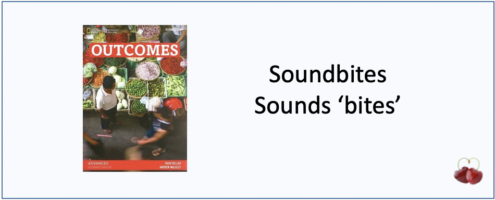57 – ‘Soundbites’
I used to think that Jungle features occurred only in recordings of spontaneous, unscripted speech. But I now realise that features of the Jungle can occur in scripted recordings for which are part of textbooks. I recently came across an example in a recording from Dellar and Walkley’s Outcomes Advanced. In unit 8 (Track 24 of the split edition) there’s a dialogue between two people talking about a holiday in the Dolomites. At one point the female speaker reassures her male listener that what he thinks is a dangerous situation (in climbing a mountain) is actually quite safe. The conversation goes
A: Really? I’m not sure I’d trust some rusty old cables
B: No, they’re fairly secure. I mean, you need a head for heights, but it’s fine.
Have a listen.
And here are the last three words ‘But it’s fine’
When I first gave this soundfile a careful listen, I thought there was something interesting happening in terms of the sound shapes of ‘but it’s fine’ so I isolated them, and made this sound file.
To my ears (it is so important to say that!) but it’s sounds close to a monosyllable bites |baɪts| or even bite |baɪt|. Depending on the quality of your audio system, and the quality of your ears you may not hear a final |s|. So what is happening? And how do we describe it? Well, here goes – first the vowel quality:
Why is the strut vowel not present, why is the vowel quality close to a trap vowel? Probably because of an accent difference – as my colleague Mark Hancock helpfully suggested – ‘the strut vowel is very open in the South of England’ close to bat |bat|. Given this vowel quality, how can we explain the rest of what is going on?
- the word but, now |bat|, experiences a t-drop |bat| and becomes |ba| and …
- the exposed vowel teams up with the vowel of it’s to form a vowel with glide sounding like the diphthong |aɪ| resulting in a syllablend bites |baɪts|
- (terms from Cauldwell, 2018)
Going back to my starting point – even in the scripted recordings of textbooks, we can expect to find Jungle features which are not adequately described by our conventional ‘rules of connected speech’. And not just in Advanced textbooks – in the Outcomes series, all levels (including Beginner) feature recordings of both slow and fast versions of sentences – which have a delightful variety of Jungle features.



Leave a Reply